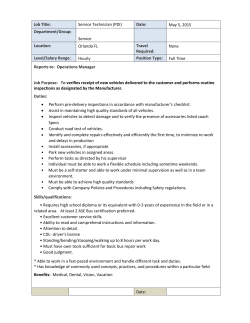
Autonomous vehicles in Benton County
Oregon State University Policy Analysis Laboratory Autonomous vehicles in Benton County: A near-‐future certainty Ivan Kuletz Problem Statement As part of their commitment to reducing traffic congestion, parking issues, and vehicle accidents, the idea of becoming a test site for autonomous vehicles – private and public – can seem like both a solution and a potential problem for Benton County, Corvallis, and OSU. This policy brief will explore the concept and provide policy recommendations. Background Autonomous vehicles (AVs) are vehicles that do not rely on constant input from a human driver for their safe operation. Most concepts of AVs still have the capacity for a human override, but models are being developed without that ability. Google, Defense Advanced Research Projects Agency (DARPA), and other groups are continually advancing and testing AV technology in places like Nevada and the San Francisco area. State and local legislation in these locations are working to get ahead of the technology, but to date it is all they can do to keep up. In Oregon, the most recent AV bill died in committee in 2013, leaving a policy vacuum that may be filled by administrative rules, such as those used by the Oregon Department of Transportation (ODOT), or smaller political units such as counties and cities. Meanwhile, other communities and universities, such as Johnson County in Iowa (home of the University of Iowa), are positioning themselves to court AV development groups. OSU, Corvallis, and Benton County could also offer an attractive research and development ground for AV and robotics groups, with the Mid-‐Valley’s temperate climate, relatively moderate street traffic, well-‐maintained roads, leading research capabilities, and OSU’s strong engineering program. Because the political will concerning AVs at the state level is not yet well formed, Benton County and its communities need to prepare for the eventuality of autonomous vehicles on 1 Oregon State University Policy Analysis Laboratory their streets. AV technology is a reality both in the laboratory and on the road, and it is highly likely to be a part of our near future. Communities – city, county, or state – that do not address AVs before they arrive could be left behind technologically, legally, and economically. The needed AV policy set must accommodate all the things drivers do in cars – but without a driver. Discussion AVs typically utilize one of two kinds of sensory technology as the foundation for their ability to drive safely and efficiently: laser-‐based 3D radar (LiDAR), or wireless communication between vehicles as well as infrastructure, such as curbs and buildings. The advantage of LiDAR is in its ability to react to novel occurrences – a legacy of its developers at DARPA. Wireless communication has the advantage of being economical, allowing for mass integration, and greatly improved highway safety and efficiency. LiDAR’s disadvantage is that at the moment it is quite expensive, running around $140,000 for a basic setup. Wireless only works with other wireless vehicles and wireless-‐enabled infrastructure such as specially built curbs, stop signs, and intersections. As such, it relies on having a critical mass of other wireless-‐capable vehicles and other wireless technology to operate. However, its primary drawback is that it is not ready to interact safely with pedestrians as the sole AV technology in a vehicle, and therefore it is not considered in this brief. To achieve economies of scope, one potential use of AVs is in applying the technology to existing public transportation systems, such as buses. While it might be tempting to replace or “enhance” public bus drivers with AV technology to improve route efficiency, in reality public transportation drivers perform a large number of non-‐routine tasks and make a large number of decisions that other drivers do not, and add a “human element” to many people’s commutes that improves ridership and civic pride all on its own. It should be noted that the low-‐hanging fruit for improving public transportation ridership is to direct public funds towards existing public transportation infrastructure. For the price of one LiDAR-‐equipped, automated public bus, you could simply have two public buses and achieve greater ridership that way. While this is an over-‐simplified equation, it demonstrates the principle. Another potential use of AVs is in making it more convenient to access public transportation. For example, autonomous routed taxis could be used to connect central public transportation routes and hubs to outlying communities. In Ukraine and other countries, such routed taxis are known as “mashrutkas,” and their usage is quite prevalent due to their reliability, speed, and low cost. At present, mashrutkas are not autonomous, but the potential is there and already being developed in at least some capacity by Google in the form of a “RoboTaxi.” 2 Oregon State University Policy Analysis Laboratory AV legislation is quite varied amongst communities that have already adopted such policies. For instance, Nevada permits usage of a handheld wireless device in an AV, but Florida bans texting while in such a vehicle. AV-‐progressive states are currently focused on defining what an autonomous vehicle is, establishing liability, and sorting out data collection and ownership. However, Oregon’s state legislation shows no momentum on any new AV bill, and so it is up to local Oregon governments to prepare for their own needs as best they can while still pushing state government to tackle the challenge. The main issues that must be solved are litigation systems and enforceable laws. To avoid the specter of sorting out AV laws, codes, and rules by tort law and already overworked courtrooms, such regulation is best prepared proactively. See “Further Reading” at the end of this document. Policy Recommendations 1) 2) 3) 4) Approach other county governments as well as ODOT to coordinate informational AV policy briefings from ODOT to all interested county and city policy members through the Area Commission on Transportation. Work with other county and city governments to push state legislators to reexamine autonomous vehicle legislation. In the interim before state legislation, work with ODOT and law enforcement personnel for advising on creating city-‐ and county-‐level policies that define what an autonomous vehicle is, who is liable in case of accident, and guidelines for safe operations. Approach communities and law enforcement agencies that already deal with large numbers of autonomous vehicles for additional advising. Once laws are in place and autonomous vehicles start to appear on Oregon roads in large numbers, educate law enforcement personnel about AVs and emerging practices and standards. Further Reading 1)http://cyberlaw.stanford.edu/wiki/index.php/Autonomous_Driving:_Legislative_and_Re gulatory_Action 2)http://www.usatoday.com/story/money/cars/2014/07/25/iowa-‐driverless-‐ cars/13159845/ 3
© Copyright 2025












